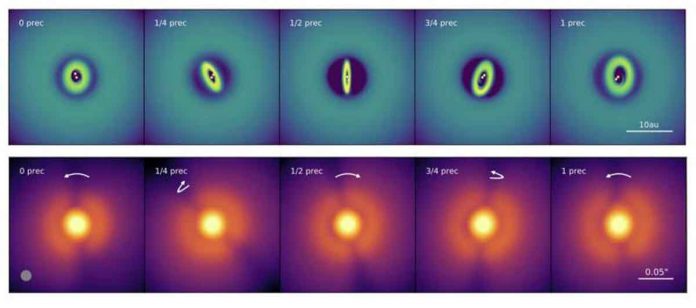The “rocking shadow” effect describes how discs in forming planetary systems are oriented and move around their host star, according to astronomers from the University of Warwick. The effect also hints at how they might evolve over time. Dr. Rebecca Nealon presented the new findings this week at the University of Warwick as part of the 2022 National Astronomy Meeting.
When a large cloud of gas and dust collapses in on itself, stars form. The leftover material that does not make it into the star circles it, similar to how water swirls around the drain before falling in. This swirling mass of gas and dust is known as a protoplanetary disc, and it is where planets like Earth form.
Protoplanetary discs are commonly imagined to be thin, round, and flat, like dinner plates. However, recent Atacama Large Millimeter/Submillimeter Array (ALMA) telescope images show that this is not always the case. ALMA observed shadows on some of the discs, where the part of the disc closest to the star blocks some of the stellar light and casts a shadow on the outer part of the disc. This shadow pattern indicates that the inner part of the disc is oriented completely differently than the outer part, resulting in a broken disc.
The team used high-performance computers to run three-dimensional simulations of a broken disc in this study. The team then created a mock observation, simulating what such a disc would look like through a telescope and how it would change over time.
The shadow cast by the inner disc moved across the outer disc as it moved through the gravitational pull of the central star. Instead of moving around the disc like a clock hand, the shadow pattern rocked back and forth in a see-saw motion. So, while the inside disc continued to rotate in the same direction, its shadow appeared to rock forward and backward. The team believes this is due to a geometric projection effect, which is common in all broken discs.
“JWST promises to give us an unprecedented look at embryonic planetary systems, and with our new models, we’ll be able to learn a lot more about the birth of planets,” says Nealon.

